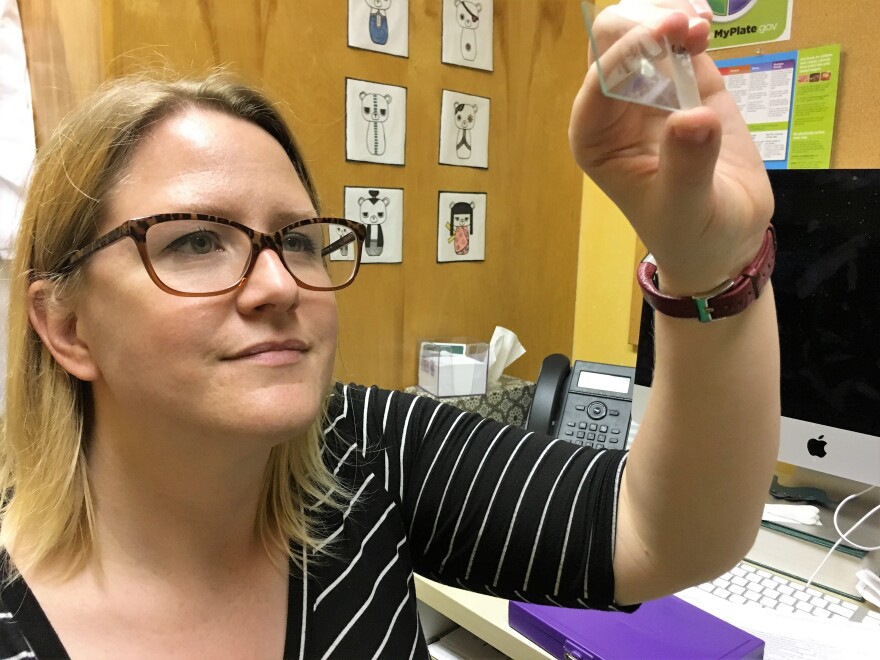Over the next few months, the Cleveland Museum of Natural History is celebrating the work of women scientists.
The kick-off included an unusual examination of the role of gender.
In this week’s Exploradio, we look at the series, and profiles one of the featured female scientists.
The Celebrating Women in Science series welcomes visitors with portraits of female scientists… in disguise.

Lexi Jamieson Marsh is director and producer of the Bearded Lady Project, a slightly tongue-in-cheek look at the inequities faced by women scientists.
Marsh says the 39 large-format, black-and-white portraits of female paleontologists sporting flamboyant fake facial hair puts a twist on the image of the rugged explorer, and poses an important question.
Marsh and her collaborators wonder whether women would receive more recognition from their peers if, like their male counterparts, they grew beards when out hunting fossils.
“If you walk by these portraits and assume it’s a man, and then all of a sudden it clicks in that wait a second, that’s a woman, does it change her credibility at all?”
The museum’s head of paleobotany and paleoecology, Denise Su, smiles beneath a massive mustache in her portrait.
'I look forward to the day when no one describes me as a female scientist, just scientist.'
Su says women often face implicit biases about not ‘looking the part’ of the traditional grizzled scientist.
“People just make certain assumptions about what you’re able to do and what you’re capable of doing based on whether or not you can grow a beard,” she says.
Su has shared her work on the habitats of early humans as part of the series.
Next week, the featured scientist is Nicole Burt, curator of human health and evolutionary medicine.
What baby teeth tell us
As the museum’s newest curator, Burt looks at how our environment, genetics, and social change has affected health over time.
Her window into the past is baby teeth.
“Teeth are really interesting for a couple of reasons: one, they start forming at a much younger age. Two, they fall out naturally,” says Burt, "so you don't have to wait for someone to die."

There’s a lot of information stored in a tooth, if you can get at it. And to do that Burt has designed a special rig, a chop saw equipped with a diamond-tipped Dremel tool blade.
“Clamp the tooth in and then you just drop a saw down and cut it,” she demonstrates.
Burt slices thin sections of teeth that reveal the layers: hard enamel, bone-like dentin, and root.
“The earliest set-down material is at the top," she says. A tooth, unlike a tree, grows from the crown down.
The baby teeth start growing in utero and provide a record of the major events in a baby’s life.
“You can actually identify the time of birth because at birth the orientation of the crystals in the teeth actually change direction.”
The tooth also marks when the baby was weaned and more importantly for Burt, what it and its mother were eating.
Moms, babies, and weaning
Our food carries a unique ratio of the stable isotopes of two elements, nitrogen and carbon, that are traceable in our teeth.
Using a process that she developed to measure the isotopes in the dentin, Burt can peer into the diets of children who lived long ago.
“So if you’re using archeological teeth not only are you studying the very early history of that child, but you’re getting a snapshot of their mother’s life as well.”
She used this new technique on teeth from kids who died more than 600 years ago in medieval England.

Burt was surprised to find that, until they died, the kids were pretty healthy.
“They seemed to go through weaning quite successfully," she says, and they were eating better than she anticipated. "Their wean diet had very high nitrogen levels, which implied they were eating more meat.”
So what put them in the cemetery?
“There was a lot of smog and pollution, and just the level of general infection...things like sinusitis.” She says chronic infections from urban living led to an early death.
Just...a scientist
Burt will share her medieval insights next week as part of the Celebrating Women in Science series. Her future plans include projects examining the health of women and children in Cleveland.
Fellow natural history museum curator Denise Su hopes the exposure to the work of women researchers and the Bearded Lady Project will begin to break down gender biases.
“I look forward to the day where no one describes me a female scientist, just scientist.”
The series runs through April with special programs and weekly presentations by local women scientists.
And none of them will be wearing a beard.










